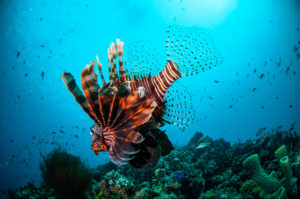 What is a lionfish?
What is a lionfish?
The red lionfish, pterois volitans, is native to the Indo-Pacific. The most common species have white and red/black/brown-striped patterns. Their characteristic venomous dorsal spikes fan out like a mane, hence the name “lionfish.” There are 18 different known species, varying in size and pattern, such as the red lionfish and the spotfin lionfish. The biggest individuals reach up to 18 inches long (45 cm). Most divers know that they’re highly venomous, packed with poison that can cause pain, swelling, sweating and respiratory distress. They are beautiful to behold, from a distance, however, and are typically not aggressive toward divers. They are nocturnal hunters and feed on a wide variety of small fish and crustaceans. During the day, they usually retreat on the reef or sit in nooks and crannies
Where do they live, and what is this “invasive species” thing all about?
The lionfish is native to and quite common on coral reefs all over the Indo-Pacific, from the coast of Eastern Africa to the South Pacific. In these areas, the population is not a problem.
However, likely due to human activity, lionfish have been haunting Atlantic and Caribbean reefs for around the last 20 years. Whether they originally arrived through accidental aquarium release or as part of a ship’s ballast water, the invasive population of lionfish has no predators in the region. Their population has thusly exploded to problematic levels from North Carolina all the way down to Bonaire, damaging and threatening local ecosystems.
These fish also have a high reproductive rate. They are sexually mature at one year old and can live up to 20 years. The situation in the Caribbean has led to lionfish culling in Florida, Honduras, Bonaire, the Bahamas, Mexico, Cayman and many other popular dive destinations. Here, divers can kill and remove lionfish from the local reefs to keep the population from growing. There are culling courses in some destinations for recreational divers, and in others only professional divers may cull the fish.
Where can I spot them?
Lionfish are not difficult to find. They are common in reefs all over the Indo-Pacific, as well as the Caribbean, unfortunately. Be careful around them, especially if they’re on the move. Although their venom will not kill you if you’re stung, it will cause intense localized pain, swelling, and possibly blistering. They are not particularly shy and make good photography subjects because of their spectacular fins.

